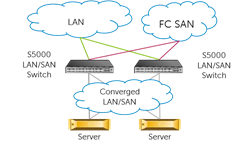At the risk of giving away my age, I fondly recall the days of using terminal servers connected to a DEC VAX mini-computer and a trusted VT100 terminal from my office desk. Local area networks (LANs) and Ethernet was in its infancy and the proposed 10Mbps speeds made our mouths water in anticipation. We’ve come a long way from those early days with Ethernet speeds now growing to 10Gbps, and higher. Fast forward to today and the explosive growth of technologies, data and applications is severely taxing existing 1Gigabit Ethernet (GbE) infrastructures. The good news is improvements in technology, price and performance now make 10GbE within reach for companies of all sizes.
Let’s spend a few moments looking at your data center and identifying areas that signal it might be time for you to make the upgrade to 10GbE. Manufacturers of today’s server and storage platforms are shipping them with 10GbE I/O’s to help alleviate bottlenecks caused by increased I/O traffic from more powerful and multi-core processors. It makes sense to take full advantage of these higher-speed I/O’s by upgrading your 1GbE infrastructure to 10GbE.
 The second area is how widespread virtualization is used throughout your data center. Many organizations have jumped on the server virtualization bandwagon to help better leverage server hardware and increase efficiencies,
The second area is how widespread virtualization is used throughout your data center. Many organizations have jumped on the server virtualization bandwagon to help better leverage server hardware and increase efficiencies,
and are moving to storage and desktop virtualization. Each virtualization technology being used within the data center imposes a network tax requiring the network to rapidly transport larger amounts of data and handle the real-time mapping of network resources between Virtual Machines (VMs) and between VM’s and storage platforms. As the use of virtualization increases, this tax on network resources multiplies by a factor and upgrading to a 10GbE will help alleviate these impacts.
 The final area is where Ethernet technology is being used for LAN’s and Fibre Channel (FC) and Internet SCSI (iSCSI) are used to meet storage area network (SAN) performance requirements. The emergence of affordable 10GbE LAN technology and standards-based technologies like Data Center Bridging (DCB) are making it possible for organizations to converge separate LAN and SAN networks into a single, multi-purpose infrastructure.
The final area is where Ethernet technology is being used for LAN’s and Fibre Channel (FC) and Internet SCSI (iSCSI) are used to meet storage area network (SAN) performance requirements. The emergence of affordable 10GbE LAN technology and standards-based technologies like Data Center Bridging (DCB) are making it possible for organizations to converge separate LAN and SAN networks into a single, multi-purpose infrastructure.
Dell networking now offers our customers a range of cost-effective 10GbE switches to fit their specific infrastructure needs and help provide a smooth migration. We are your path to a new, modern network.
- For rack-based data centers, Dell offers the S4810, S4820T and S6000 switches with a combination of 1/10/40GbE ports. These high-performance top-of-rack (TOR) switches help to aggregate many 1/10GbE interconnects within the rack while also providing a 40GbE uplink to the data center fabric. The S4820T has 10GBASE-T ports which are backward-compatible with 1GbE ports.
- Data centers that use chassis blade systems can purchase the Dell MXL blade switch. This 1/10/40GbE blade switch supports internal 1/10GbE ports as well as 2 fixed and 4 modular 40GbE ports.
- To help IT managers combine separate LAN and SAN networks, Dell offers the S5000 converged LAN/SAN switch. This switch supports 1/10/40GbE ports and provides a wide range of services including Ethernet, iSCSI, native FC, and Fibre Channel over Ethernet (FCoE) as well as DCB.
We’ve certainly come a long way from those bold beginnings of 10Mbps Ethernet. It’s a safe assumption that application and user demand in your data center network will continue to grow. Thanks to 10GbE technology, price and performance, now may be the right time to upgrade your data center switching infrastructure. Come talk to Dell about our wide selection of 10GbE switch solutions and we’ll make sure you have the right switch for your data center environment and provide the experience and services to help you accomplish this migration smoothly. Get started now by following @DellNetworking. Looking forward to hearing from you.